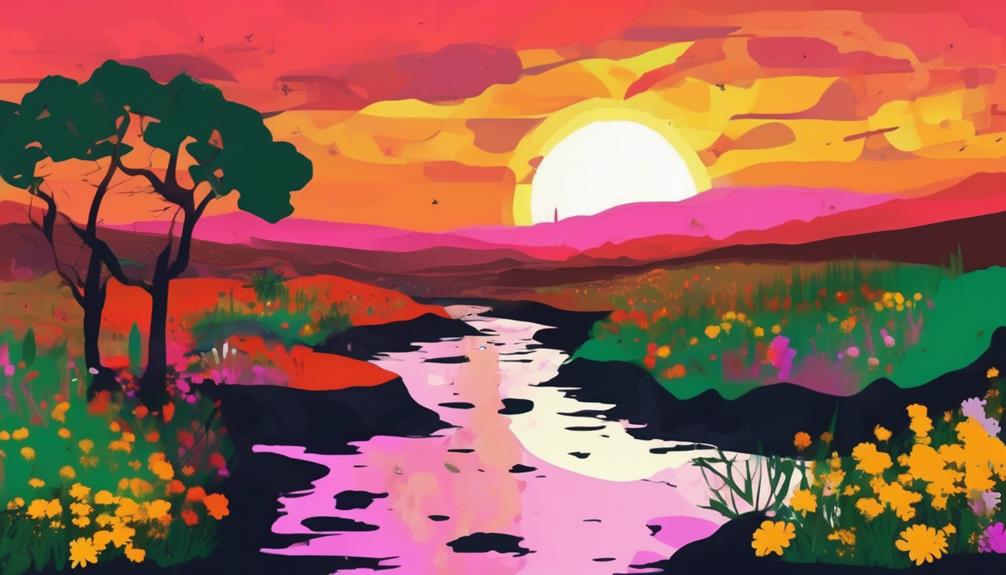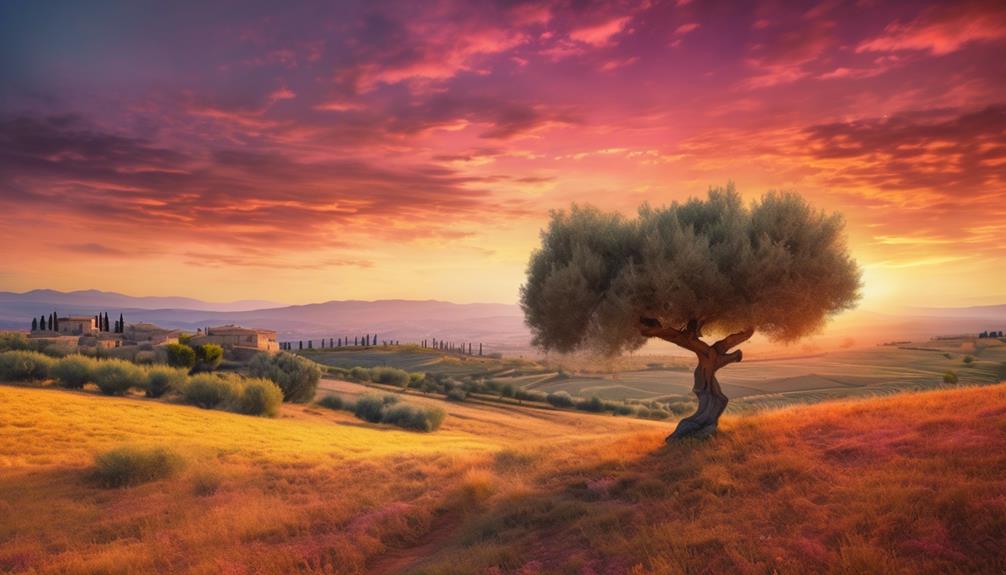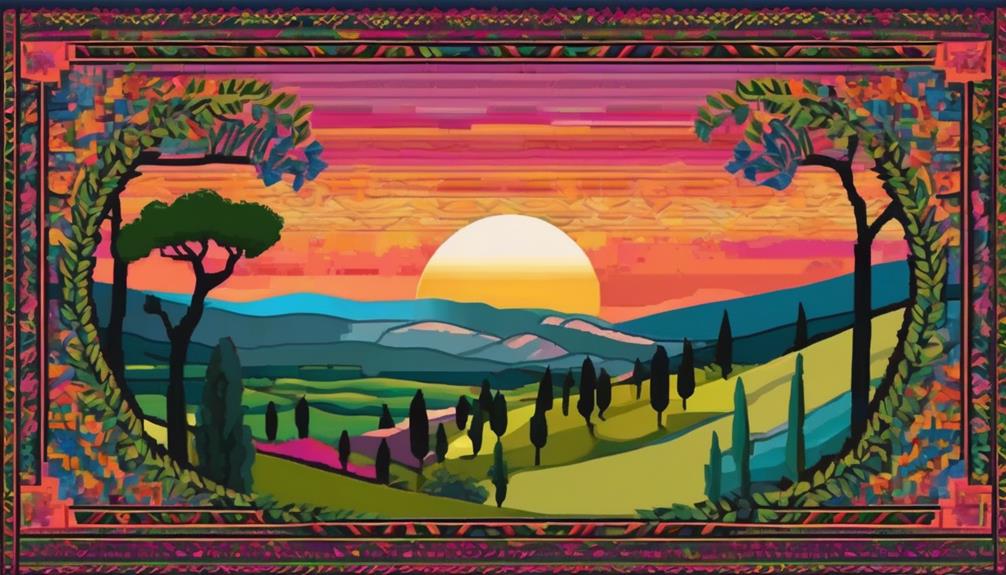When exploring the intersection of Etel Adnan's artistry and Palestine, a mesmerizing journey unfolds. Her profound connection to the land and its people transcends mere brushstrokes or words on a page. Through her work, Adnan explores layers of history and emotion, offering a unique perspective that resonates far beyond the canvas. The essence of her artistic expression not only portrays the beauty of Palestine but also stands as a tribute to the enduring spirit of a nation marked by both struggle and resilience.
Etel Adnan's Artistic Journey

Etel Adnan started her artistic journey with a passion for capturing the essence of her homeland through vibrant colors and bold brushstrokes. She believed that art was a powerful medium to express the beauty and turmoil of her surroundings. Adnan's early works reflected the rich cultural tapestry of Lebanon, her birthplace.
As she explored further into her craft, Adnan's style evolved, becoming more abstract yet deeply rooted in emotion. Her paintings not only depicted landscapes but also conveyed a sense of nostalgia and longing for a place she held dear. Adnan's use of color became more nuanced, blending hues to evoke a sense of unity amidst diversity.
Over time, Adnan's art garnered attention for its unique blend of Eastern and Western influences. Critics praised her ability to transcend boundaries, creating pieces that spoke to the universal human experience.
Adnan's journey as an artist was marked by a relentless pursuit of truth and beauty, a quest that continues to inspire aspiring artists worldwide.
Palestinian Landscapes in Art
Explore the depiction of Palestinian landscapes in art, capturing the essence of the region's beauty and complexities through various artistic interpretations. Palestinian landscapes have been a prominent subject in art, with artists using different styles and mediums to convey the unique characteristics of the region. From vibrant paintings to intricate drawings, these artworks often showcase the rich history, culture, and struggles of the Palestinian people through their connection to the land.
Artists frequently portray the diverse terrain of Palestine, including its rolling hills, ancient olive groves, bustling markets, and vibrant cities. These depictions aim to not only capture the physical beauty of the landscapes but also to convey the deep emotional ties that Palestinians have to their homeland.
Through their art, these creators offer viewers a glimpse into the complexities of Palestinian identity, history, and resilience, all intertwined with the ever-changing landscapes of the region. Whether through realism, abstraction, or symbolism, these artistic representations serve as powerful reminders of the enduring spirit of the Palestinian people and their deep-rooted connection to their land.
The Power of Poetry

Explore the transformative influence of poetry as it illuminates the depths of human emotion and experience, transcending boundaries and connecting individuals through the power of words.
Poetry has the remarkable ability to capture the essence of a moment, a feeling, or a place with striking clarity, evoking powerful emotions within its readers. Through carefully chosen words and evocative imagery, poetry can transport you to distant lands, immerse you in different cultures, and provide a window into the hearts and minds of others.
The power of poetry lies in its ability to speak to the universal human experience, resonating with people from all walks of life. Whether it's a poem about love, loss, joy, or anguish, poetry has the capacity to create empathy and understanding between individuals, fostering a sense of connection and shared humanity.
In a world often divided by differences, poetry serves as a unifying force, reminding us of our common emotions and experiences that bind us together as human beings.
Exploring Cultural Identity
Explore the intricate weave of cultural identity as it shapes perspectives and influences personal narratives. Your cultural identity is like a mosaic, made up of various pieces that reflect your heritage, beliefs, traditions, and experiences. It's a dynamic blend of influences from your family, community, and the society you live in.
This rich tapestry of cultural identity impacts how you see the world, how you interact with others, and how you express yourself. Embracing your cultural identity can provide a sense of belonging and connection to your roots. It shapes your values, shapes your worldview, and influences your creativity.
Through exploring your cultural identity, you can gain a deeper understanding of who you're and where you come from. It's a journey of self-discovery that can help you navigate the complexities of the world with a stronger sense of self-awareness and appreciation for diversity.
Reflections on Occupation

Reflecting on occupation, you can't overlook the profound impact it has on shaping personal narratives and cultural identities. Living under occupation means living with constant restrictions, checkpoints, and the looming presence of a controlling force. It seeps into every aspect of life, influencing daily routines, choices, and even aspirations.
Occupation fractures communities, separates families, and instills a sense of fear and uncertainty. The experience of occupation becomes ingrained in the collective memory, shaping the stories passed down through generations. It becomes a defining feature of identity, a struggle that unites individuals in their shared resistance against oppression.
The occupation not only impacts the physical landscape but also the emotional and psychological well-being of those affected. It breeds a sense of resilience, a determination to preserve cultural heritage and hold onto one's roots in the face of adversity.
In the midst of occupation, voices like Etel Adnan's emerge, offering a perspective that transcends borders and speaks to the universal struggle for freedom and dignity. Through art, literature, and activism, these voices reclaim narratives, humanize experiences, and shed light on the enduring spirit of a people under occupation.
Humanizing Palestinian Narratives
Humanizing Palestinian narratives involves amplifying the voices of individuals to convey the depth of their experiences under occupation. By sharing personal stories, struggles, and triumphs, these narratives become more relatable and impactful.
When individuals speak about their lives, hopes, and challenges, it humanizes the larger political conflict, making it tangible and real.
Through these personal accounts, we gain insight into the daily realities faced by Palestinians living under occupation. It's through these narratives that we can understand the resilience, courage, and determination of individuals working towards a better future despite adversity.
By listening to these voices, we acknowledge the humanity that often gets overshadowed in discussions about conflict and politics.
Humanizing Palestinian narratives is about recognizing the shared humanity that binds us all together. It's through these individual stories that we can build empathy, understanding, and solidarity.
Colors of Resilience

To truly grasp the resilience of Palestinian individuals, you must immerse yourself in the vibrant colors that paint their stories of perseverance and strength. The Palestinian spirit shines through the hues of their daily lives, reflecting a deep-rooted determination to thrive despite adversity. Each color tells a tale of resistance, hope, and unwavering resilience in the face of challenges.
| Color | Representation |
|---|---|
| Olive Green | Symbolizes endurance and peace, rooted in the land Palestinians cherish. |
| Majestic Blue | Reflects the vastness of the sky and sea, embodying freedom and resilience. |
| Sunflower Yellow | Represents the bright spirit and optimism that fuels Palestinian resilience. |
The colors of resilience in Palestine are not just visual; they are a living proof to the unwavering strength of a people who continue to persevere despite the odds. By embracing these vibrant hues, you can begin to understand the depth of Palestinian resilience and the beauty that emerges from adversity.
Intersection of Art and Activism
Art and activism intersect powerfully in the Palestinian community, igniting change and resilience through creative expression. Through art, Palestinians amplify their voices, shedding light on the injustices they face and advocating for their rights on a global stage.
Visual arts, music, poetry, and other forms of creative expression serve as significant tools to challenge the status quo, provoke thought, and inspire action.
Activism in Palestine is deeply intertwined with art, as artists use their platforms to raise awareness about political issues, human rights violations, and the ongoing struggle for freedom and justice. Art becomes a means of resistance, a way to reclaim narratives, and a form of protest against oppression.
Whether through murals on city walls, powerful poetry performances, or stirring musical compositions, Palestinian artists play an essential role in shaping the discourse surrounding their community's experiences and aspirations.
Embracing Palestinian Heritage

Exploring the rich tapestry of Palestinian heritage offers a profound connection to the land's history and cultural identity. By immersing yourself in Palestinian traditions, such as intricate embroidery, vibrant cuisine, and storytelling passed down through generations, you can gain a deeper appreciation for the resilience and beauty of Palestinian culture. Visiting historical sites like the ancient city of Jericho or the bustling markets of Bethlehem allows you to witness firsthand the layers of history that have shaped Palestinian identity over centuries.
Engaging with Palestinian heritage is a way to honor the struggles and triumphs of the Palestinian people, preserving traditions that have withstood the test of time. Whether you participate in traditional dabke dancing, savor the flavors of maqluba, or learn about the symbolism behind Palestinian art forms, each experience contributes to a more profound understanding of the cultural richness of Palestine.
Embracing Palestinian heritage not only connects you to the past but also strengthens the bond between generations and fosters a sense of unity within the Palestinian community.
Adnan's Impact on Contemporary Art
Explore how Etel Adnan has influenced contemporary art with her unique perspective and artistic expressions. Adnan's impact on the art world is profound, shaping the way artists approach themes of identity, memory, and place.
Her vibrant use of color and abstract forms has inspired a new generation of creators to push boundaries and challenge traditional artistic norms.
By infusing her work with elements of her Lebanese and Palestinian heritage, Adnan has sparked conversations about cultural representation and the power of art to convey complex emotions and experiences. Many contemporary artists now look to Adnan as a trailblazer who fearlessly explores the intersections of politics, art, and personal history.
Adnan's ability to capture the essence of landscapes and emotions in her paintings and writings has influenced artists across various mediums, from visual arts to literature. Her dedication to expressing the beauty and complexity of the world around her serves as a guiding light for those seeking to make meaningful connections through their art.
Conclusion
You have journeyed through Etel Adnan's artistic exploration of Palestine, witnessing the beauty and complexities of the region through her vibrant landscapes and poignant poetry.
Her work reflects a deep connection to Palestinian heritage and a resilience that shines through despite the occupation.
Adnan's impact on contemporary art is undeniable, serving as a powerful voice for the Palestinian people and their collective memory.
Keep exploring the colors of resilience in her art.